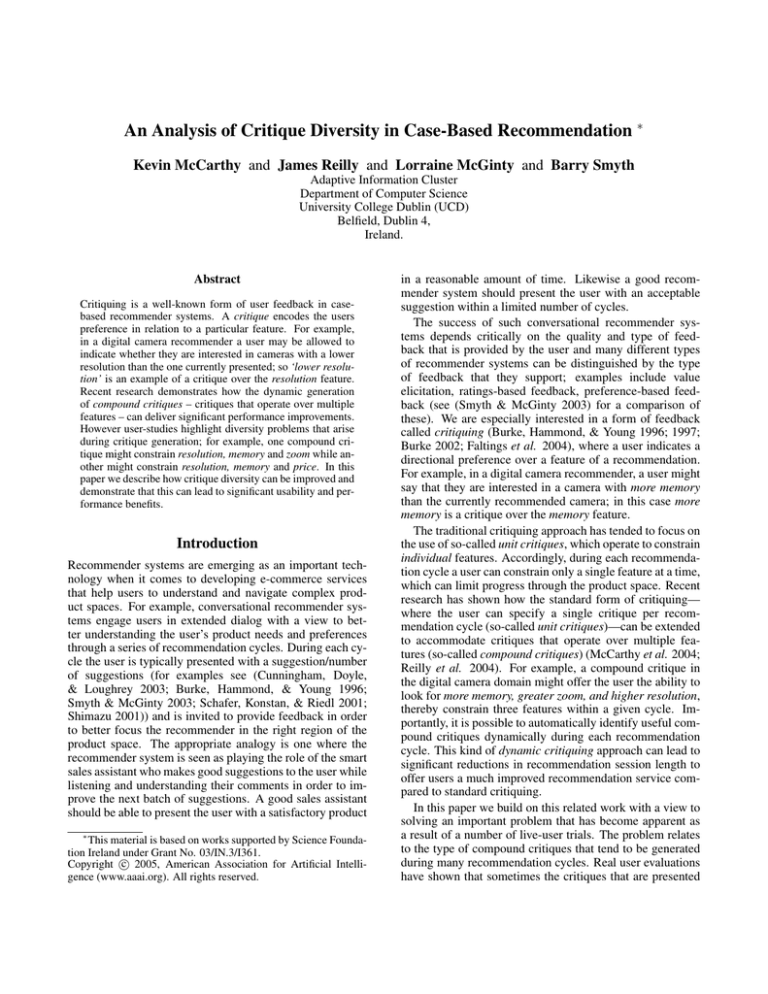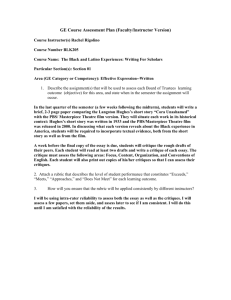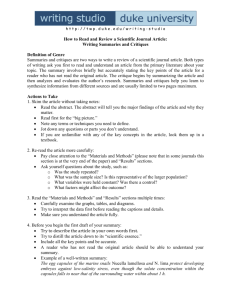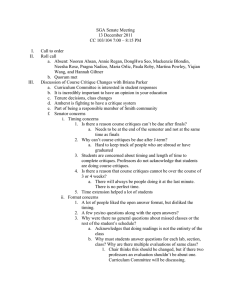
An Analysis of Critique Diversity in Case-Based Recommendation ∗
Kevin McCarthy and James Reilly and Lorraine McGinty and Barry Smyth
Adaptive Information Cluster
Department of Computer Science
University College Dublin (UCD)
Belfield, Dublin 4,
Ireland.
Abstract
Critiquing is a well-known form of user feedback in casebased recommender systems. A critique encodes the users
preference in relation to a particular feature. For example,
in a digital camera recommender a user may be allowed to
indicate whether they are interested in cameras with a lower
resolution than the one currently presented; so ‘lower resolution’ is an example of a critique over the resolution feature.
Recent research demonstrates how the dynamic generation
of compound critiques – critiques that operate over multiple
features – can deliver significant performance improvements.
However user-studies highlight diversity problems that arise
during critique generation; for example, one compound critique might constrain resolution, memory and zoom while another might constrain resolution, memory and price. In this
paper we describe how critique diversity can be improved and
demonstrate that this can lead to significant usability and performance benefits.
Introduction
Recommender systems are emerging as an important technology when it comes to developing e-commerce services
that help users to understand and navigate complex product spaces. For example, conversational recommender systems engage users in extended dialog with a view to better understanding the user’s product needs and preferences
through a series of recommendation cycles. During each cycle the user is typically presented with a suggestion/number
of suggestions (for examples see (Cunningham, Doyle,
& Loughrey 2003; Burke, Hammond, & Young 1996;
Smyth & McGinty 2003; Schafer, Konstan, & Riedl 2001;
Shimazu 2001)) and is invited to provide feedback in order
to better focus the recommender in the right region of the
product space. The appropriate analogy is one where the
recommender system is seen as playing the role of the smart
sales assistant who makes good suggestions to the user while
listening and understanding their comments in order to improve the next batch of suggestions. A good sales assistant
should be able to present the user with a satisfactory product
∗
This material is based on works supported by Science Foundation Ireland under Grant No. 03/IN.3/I361.
c 2005, American Association for Artificial IntelliCopyright °
gence (www.aaai.org). All rights reserved.
in a reasonable amount of time. Likewise a good recommender system should present the user with an acceptable
suggestion within a limited number of cycles.
The success of such conversational recommender systems depends critically on the quality and type of feedback that is provided by the user and many different types
of recommender systems can be distinguished by the type
of feedback that they support; examples include value
elicitation, ratings-based feedback, preference-based feedback (see (Smyth & McGinty 2003) for a comparison of
these). We are especially interested in a form of feedback
called critiquing (Burke, Hammond, & Young 1996; 1997;
Burke 2002; Faltings et al. 2004), where a user indicates a
directional preference over a feature of a recommendation.
For example, in a digital camera recommender, a user might
say that they are interested in a camera with more memory
than the currently recommended camera; in this case more
memory is a critique over the memory feature.
The traditional critiquing approach has tended to focus on
the use of so-called unit critiques, which operate to constrain
individual features. Accordingly, during each recommendation cycle a user can constrain only a single feature at a time,
which can limit progress through the product space. Recent
research has shown how the standard form of critiquing—
where the user can specify a single critique per recommendation cycle (so-called unit critiques)—can be extended
to accommodate critiques that operate over multiple features (so-called compound critiques) (McCarthy et al. 2004;
Reilly et al. 2004). For example, a compound critique in
the digital camera domain might offer the user the ability to
look for more memory, greater zoom, and higher resolution,
thereby constrain three features within a given cycle. Importantly, it is possible to automatically identify useful compound critiques dynamically during each recommendation
cycle. This kind of dynamic critiquing approach can lead to
significant reductions in recommendation session length to
offer users a much improved recommendation service compared to standard critiquing.
In this paper we build on this related work with a view to
solving an important problem that has become apparent as
a result of a number of live-user trials. The problem relates
to the type of compound critiques that tend to be generated
during many recommendation cycles. Real user evaluations
have shown that sometimes the critiques that are presented
to a user can lack diversity; in other words, they tend to constrain similar feature groups. For example, we might find
that one of the compound critiques that is presented to the
user during the current session allows the user to opt for a
camera with a higher resolution, less memory, greater price
while another might offer cameras with higher resolution,
less memory, greater zoom. The point is that both of these
critiques constrain two of the same three features thus limiting the scope of the feedback that is on offer to the user. We
believe that offering the user a more diverse set of critiques
will improve the usability and applicability of the compound
critiques so that users are more likely to select these critiques
in favour of the standard unit critiques. We present an algorithm for generating compound critiques with a given degree
of diversity and we evaluate the ability of these critiques to
deliver efficient recommendation sessions.
Background
In this section, we discuss the standard unit-critiquing approach as it relates to conversational case-based recommender systems, before describing how static compound
critiques can be presented to users as feedback options. The
later (and main) focus of this section, however, describes
how compound critiques are generated on-the-fly by the dynamic critiquing approach.
A Traditional Approach to Critiquing
The origins of critiquing as a form of feedback can be traced
back to the work of Burke et al. (Burke, Hammond, &
Young 1996; 1997; Burke 2002) and the FindMe approach
to recommender systems development. The work was originally motivated by a form of feedback that was simple for
users to use and that still provided sufficient guidance to
the recommender system. The Entree recommender (Burke,
Hammond, & Young 1996) demonstrated the power of the
critiquing approach by helping users to locate restaurants using a set of fixed critiques over features such as style, cuisine,
price etc. For example, the user may request another restaurant that is cheaper or more formal, by critiquing its price
and style features, respectively.
The above critiques are all examples of what we call unit
critiques. They express preferences over single features;
cheaper critiques a price feature, more formal critiques a
style feature, for example. This ultimately limits the ability of the recommender to make progress through a product
space because constraining a single feature per cycle will
tend to eliminate only a few cases at a time. Constraining multiple features in a single cycle offers some obvious
attractions, leading to the idea of compound critiques that
operate over multiple features simultaneously. This idea
of compound critiques is not novel; the seminal work of
(Burke, Hammond, & Young 1996) refers to critiques for
manipulating multiple features. They give the example of
the sportier critique, in a car recommender, which operates
over a number of different car features; engine size, acceleration and price are all increased. Similarly we might use a
more professional compound critique in a digital camera recommender to simultaneously manipulate resolution, zoom,
and memory features, for example.
In the past when compound critiques have been used they
have been hard-coded by the system designer so that the user
is presented with a fixed set of compound critiques in each
recommendation cycle. These compound critiques may, or
may not, be relevant depending on the cases that remain at a
given point in time. For instance, in the context of the example above the more professional critique might continue to
be presented as an option to the user despite the fact that
the user may have already seen and declined all cameras
from this region of the product space. Far more preferable is the ability to selectively generate such compound
critiques as are appropriate given the region of the product space that the user appears to be interested in. Recently
such an approach has been proposed (McCarthy et al. 2004;
Reilly et al. 2004) where compound critiques are generated
on-the-fly, for each recommendation cycle. In the next section we describe this approach.
Dynamic Critiquing
A simplified version of the dynamic critiquing algorithm is
shown in Figure 1. From a user’s perspective dynamic critiquing operates in a manner that is similar to more conventional forms of critiquing. That is, each recommendation session is initiated by an initial user query; each cycle
presents the user with a set of recommendations and feedback options (in this case both unit and compound critiques);
the user is afforded the opportunity to accept a suggestion or
to apply a critique to guide the next cycle. However, the
manner in which compound critiques are identified and selected for presentation to the user is novel. First of all, unlike
more traditional, static forms of critiquing, the compound
critiques are generated on-the-fly as part of each recommendation cycle and with references to the cases that are remaining at that point. Second, a subset of the generated critiques
are selected and presented to the user.
Dynamically generating and selecting compound critiques to present to the user is covered by lines 17-21 of the
given algorithm and refers to a three-step process: (1) the
generation of critique patterns, (2) the mining of compound
critiques, and (3) the grading of compound critiques. To
avoid unnecessary confusion these steps are not expanded in
the algorithm provided, but instead are described next.
From Cases to Critique Patterns - In order to discover a
useful set of compound critiques from a set of product cases
we need to first understand how these cases relate to the current recommendation. In other words we need to understand
their basic feature differences so that we may then look for
frequently occurring sets of differences to act as our compound critiques. The first step is to generate a set of so-called
critique patterns from the remaining cases. Each remaining
case is compared to the current recommended case and the
relative feature differences make up the critique pattern.
Figure 2 illustrates what happens in the GenerateCP
method (line 18 of Figure 1) with the aid of an example
from the digital cameras (DC) domain. It shows the current
case that has been selected for recommendation to the user
as part of the current cycle, and a random case, c, from the
case-base. The current case describes a Canon digital cam-
era with 5.1M Pixel resolution, 3X optical zoom and 32Mb
of storage for 443 Euro. Case c describes a Sony camera
with 5.0 M Pixel Resolution, 4X optical zoom and 16Mb of
storage for 455 Euro. The resulting critique pattern reflects
how case c differs from current case in terms of individual
feature critiques. For example, the critique pattern shown
includes a “<” critique for Storage Included— we will refer to this as [StorageIncluded <]—because the comparison case has a less memory storage than the current recommended case. Similarly, the pattern includes the critique
[P rice >] because the comparison case is more expensive
than the current case.
Generating Compound Critiques - To identify compound critiques we must look for recurring patterns within
a set of critique patterns. Each product case has a number of features and each numeric feature can have a “<”
or a “>” critique and each nominal feature can have a “=”
or a “! =” critique, so there are 2n possible critiques in
a case-base where the cases are made up of n individual
features. The Apriori algorithm (R. Agrawal & Verkamo.
1996) used to characterise recurring item-subsets as association rules of the form A → B: from the presence of
a certain set of critiques (A) one can infer the presence
of certain other critiques (B). For example, when buying a
Digital Camera you might expect to pay more money for
more Resolution, so there is a relationship between these
two critiques: [Resolution >] infers [P rice >]. This part
of the algorithm returns compound critiques of the form
{[Resolution >], [P rice >]} along with a measure of their
support. The support value refers to the percentage of critique patterns for which the compound critique is valid. During each recommendation cycle Apriori is used to generate a
collection of compound critiques (frequent itemsets over the
critique patterns, CPs), see line 19 of Figure 1. Then, during
the next step, a subset of the best of these compound critiques is chosen for presentation to the user to complement
the standard unit critiques.
Grading & Selecting Compound Critiques - From a
user interface and availability viewpoint it is not practical
to present large numbers of different compound critiques,
as feedback options, to the user during each cycle. However, large numbers of compound critiques are likely to be
discovered. A filtering strategy is needed so that the most
useful critiques can be selected, say the top 5, for presentation purposes. One option is to use the support value of
the critique as the basis for filtering. Related work (Reilly
et al. 2004) has evaluated many different strategies with
respect to their ability to improve recommendation performance, finding that the so-called low-support (LS) strategy
offers superior benefits, as they are capable of eliminating
many cases. In the algorithm (Figure 1) the compound critiques are ranked by RateCC (see lines 22-27, Note: div is
set to off in this standard approach). Figure 3(a) illustrates
the final result from a digital camera recommender, where
a recommendation for a specific camera is presented to the
user. Standard unit critiques are presented alongside each individual feature, while 3 dynamically generated compound
critiques appear below the current case description.
Figure 1: The dynamic critiquing algorithm.
Figure 2: Generating a critique pattern.
Compound Critique Diversity
There are a number of problems with the proposed approach
to dynamic compound critique generation. In a recent realuser study on dynamic critiquing, a number of trialists complained that their options were frequently limited by compound critiques that lacked diversity among their feature
constraints. Figure 3(a) shows a typical example in which
a camera is presented to the user along with three compound
critiques. The problem is that these three different critiques
expected performance gains (previously reported by (Reilly
et al. 2004)) in relation to recommendation efficiency were
compromised.
By way of a solution, in this section we describe a technique for increasing the relative diversity of the compound
critiques that are selected for presentation to the user. The
solution comes in two parts. First, we present the overall diversity enhancement algorithm, which depends on a metric
for measuring the relative diversity of a pair of compound
critiques. Second, we present two alternative strategies for
measuring relative compound critique diversity.
Diversity Enhancement
The default strategy for selecting a short-list of k compound
critiques for recommendation to the user is to select those
critiques with the lowest support values. But we are concerned because this strategy does not consider the relationship between the critiques that are chosen, which may lead
to diversity problems. This is analogous to a very familiar and related problem in recommender systems, whereby
cases selected for retrieval because they are maximally similar to the current query tend also to be very similar to
each other. This problem has been addressed by a number
of diversity-enhancing retrieval techniques (Bridge 2002;
McGinty & Smyth 2003; McSherry 2001; 2002; Shimazu
2001), and we believe that similar methods can be adopted
to improve the diversity of our compound critiques.
The diversity enhancing algorithm described by (Smyth &
McClave 2001) selects cases on the basis of a quality metric
that maximizes similarity to the current query, while minimizing average similarity to cases selected so far. A similar
metric can be defined for compound critiquing as shown in
E.q. 1 (where c is the current critique and P are the critique options presented to the user so far). Accordingly we
give preference to compound critiques that have low support
scores, and that are diverse relative to any compound critiques that have been so far selected for presentation for the
current cycle. Importantly, this quality metric also allows
us to adjust the relative emphasis that is placed on diversity
during critique selection.
Qual(c, P ) = α∗(1−Support(c))+(1−α)∗Overlap(c, P )
(1)
Relative Critique Diversity
Figure 3: Recommendation cycles for digital cameras with
both unit and compound critiques; (a) standard compound
critiques, (b) diverse compound critiques.
overlap considerably in terms of their individual critiques
thus limiting their applicability. During trials this problem
manifested itself by a reluctance of users to select compound critiques over unit critiques, and for this reason the
Our quality metric above relies on a technique for measuring
the relative diversity of a pair of compound critiques. There
are two ways that we might do this. The most direct approach is to consider the overlap between the unit critiques
that make up a compound critique; see Eq. 2 for (featureoverlap). Alternatively, we can measure relative diversity
indirectly by computing the overlap between the cases that
the critiques satisfy. In other words, two critiques are considered to be diverse if they satisfy different groups of cases;
see Eq. 3 for (case-overlap).
F overlap(c, P ) = 1 −
|critiques({c}) ∩ critiques(P )|
|critiques({c}) ∪ critiques(P )|
(2)
C overlap(c, P ) = 1 −
|cases({c}) ∩ cases(P )|
|cases({c}) ∪ cases(P )|
(3)
In this work we propose to investigate these two approaches to improving the diversity of compound critiques
that are presented to the user during a recommendation cycle. Both approaches adopt the standard greedy selection,
diversity enhancing algorithm proposed by (Smyth & McClave 2001). Figure 1, lines 28 - 35, shows the DiverseSelection function; where Quality is calculated by Equation
1 and using different overlap strategies (Equation 2 & 3)
according to the experiment being executed. The featureoverlap strategy considers the overlap between the unit critiques that make up a compound critique, whereas the caseoverlap strategy considers the the overlap between the cases
that critiques satisfy.
If α is set to 1, the compound critiques will be selected on
support alone (overlap not considered; no diversity enhancement), whereas if α is set to 0 the compound critiques will
be selected based solely on overlap (support not considered;
full diversity enhancement).
Evaluation
The motivation for increasing critique diversity is to improve
the degree of variation that is presented to end-users. The
two diversity approaches above will achieve this and in this
section we will evaluate the degree to which critique diversity is improved in practice and how this impacts the general
applicability of the resulting critiques. Of course there is a
risk to increasing critique diversity. By definition we will be
rejecting some compound critiques that are highly rated and
favour less highly rated ones that are more diverse. These
less highly rated critiques may be less efficient at guiding
recommendation and so may degrade recommendation efficiency. We will also investigate this issue in the evaluation
that follows.
Setup & Methodology
In this evaluation our experimental set-up and methodology
is the same as that used by (Reilly et al. 2004). In our
experiments we use a PC dataset, consisting of 120 cases,
each describing a single PC or laptop in terms of features
such as price, manufacturer, CPU, Memory etc. We compare
three versions of our algorithm: standard, case-overlap and
feature-overlap. The case and feature-overlap strategies are
the diversity enhanced versions of the algorithm described
above and we evaluate these approaches with different levels of diversity. The standard strategy refers to the basic lowsupport selection strategy described by (Reilly et al. 2004)
in which compound critiques are selected solely on the basis
of their support values (i.e., no diversity enhancement). This
evaluation was carried out using the standard leave-one-out
methodology with an artificial user as described in (Reilly et
al. 2004).
Diversity Improvements
In the first of the experiments we looked at the average overlap of the critiques being presented to the users for the different levels of diversity. (The overlap is found by performing
a pairwise comparison between the critiques and computing
the overlap between their unit critiques.) We get different
levels of diversity by varying the “α” value in Equation 1.
Figure 4: Overlap results for varying α.
Figure 4 shows that when there is no diversity enhancement (α=1) the overlap is about 0.3. Given that the average
compound critique contains about 3 unit critiques this means
that we can expect our compound critiques to share one unit
critique, on average, with the other presented compound critiques. As the level of diversity enhancement is increased
(by lowering α) we can see that the overlap of the compound critiques decreases for both case and feature overlap strategies, although more-so for feature overlap strategies. The overlap values keep on decreasing as the diversity
enhancement increases as expected. Also as expected, the
feature-overlap technique produces more diverse critiques
as it directly affects the critiques as it is calculated using
the unit critiques within the candidate compound critiques.
Whereas the case-overlap strategy affects the critiques in an
indirect manner as it is calculated based on the cases in the
casebase that satisfy the compound critique. The case and
feature overlap strategies can improve the diversity of the
compound critiques up to 28% and 62% respectively. The
62% improvement for feature overlap strategies, in particular, indicates that its compound critiques are unlikely to
share any unit critiques. Thus compound critiques generated
using these methods are unlikely to share unit critiques.
Recommendation Efficiency
Recommendation efficiency is one of the key motivations of
this work. Importantly, introducing diversity to improve the
quality of the critiques options presented to the user, should
not increase recommendation session length. Figure 5 looks
at the effect our diversity enhancing algorithms have on efficiency. The results show that the introduction of more diverse critiques actually improves the efficiency results. Although this improvement is small it is nonetheless important as it means that we can safely increase the diversity of
the compound critiques presented without affecting the efficiency of our system.
Figure 5: Efficiency results for varying α.
Conclusions
Dynamic critiquing has been previously shown to offer significant recommendation performance benefits by generating compound critiques that operate over multiple case features (McCarthy et al. 2004; Reilly et al. 2004). In this paper we have addressed a known shortcoming related to the
lack of potential diversity between alternative compound critiques. We have described a diversity enhancing approach to
compound critique generation and compared two alternative
strategies for evaluating critique diversity.
Our evaluation results demonstrate that this technique is
capable of generating diverse compound critiques that are
likely to be more acceptable to users in practice. The
diversity-enhancing approach carries an inherent performance risk because rejecting high quality critiques on the
grounds that they lack diversity will lead to the selection
of lower quality (albeit more diverse) critiques and this
may lead to performance sacrifices. Our results, however,
demonstrate that diverse compound critiques can be presented to the user without compromising recommendation
efficiency.
References
Bridge, D. 2002. Diverse Product Recommendations using
an Expressive Language for Case Retrieval. In Craw, S.,
and Pearce, A., eds., Proceedings of the Sixth European
Conference on Case-Based Reasoning (ECCBR 2002), 42–
57. Springer. Aberdeen, Scotland.
Burke, R.; Hammond, K.; and Young, B.
1996.
Knowledge-based navigation of complex information
spaces. In Proceedings of the Thirteenth National Conference on Artificial Intelligence, 462–468. AAAI Press/MIT
Press. Portland, OR.
Burke, R.; Hammond, K.; and Young, B. 1997. The
FindMe Approach to Assisted Browsing. Journal of IEEE
Expert 12(4):32–40.
Burke, R. 2002. Interactive Critiquing for Catalog Navigation in E-Commerce. Artificial Intelligence Review 18(34):245–267.
Cunningham, P.; Doyle, D.; and Loughrey, J. 2003. An
Evaluation of the Usefulness of Case-Based Explanation.
In Ashley, K., and Bridge, D., eds., Case-Based Reasoning
Research and Development. LNAI, Vol. 2689., 191–199.
Springer-Verlag. Berlin.
Faltings, B.; Pu, P.; Torrens, M.; and Viappiani, P.
2004. Design Example-Critiquing Interaction. In Proceedings of the International Conference on Intelligent
User Interface(IUI-2004), 22–29. ACM Press. Funchal,
Madeira, Portugal.
McCarthy, K.; Reilly, J.; McGinty, L.; and Smyth, B.
2004. On the Dynamic Generation of Compound Critiques
in Conversational Recommender Systems. In Bra, P. D.,
ed., Proceedings of the Third International Conference on
Adaptive Hypermedia and Web-Based Systems (AH-04).
Springer. Eindhoven, The Netherlands.
McGinty, L., and Smyth, B. 2003. The Role of Diversity in Conversational Systems. In Bridge, D., and Ashley,
K., eds., Proceedings of the Fifth International Conference
on Case-Based Reasoning (ICCBR-03). Springer. Troindheim, Norway.
McSherry, D. 2001. Increasing Recommendation Diversity
Without Loss of Similarity. In Proceedings of the Sixth UK
Workshop on Case-Based Reasoning, 23–31. Cambridge,
UK.
McSherry, D. 2002. Diversity-Conscious Retrieval. In
Craw, S., ed., Proceedings of the Sixth European Conference on Case-Based Reasoning (ECCBR-02), 219–233.
Springer. Aberdeen, Scotland.
Agrawal, R.; Mannila, H.; and Verkamo., A. I. 1996.
Fast Discovery of Association Rules in Large Databases.
Advances in Knowledge Discovery and Data Mining 307–
328.
Reilly, J.; McCarthy, K.; McGinty, L.; and Smyth, B. 2004.
Dynamic Critiquing. In Calero, P. A. G., and Funk, P., eds.,
Proceedings of the European Conference on Case-Based
Reasoning (ECCBR-04). Springer. Madrid, Spain.
Schafer, J. B.; Konstan, J. A.; and Riedl, J. 2001. ECommerce Recommendation Applications. Data Mining
and Knowledge Discovery 5(1/2):115–153.
Shimazu, H. 2001. ExpertClerk : Navigating Shoppers’ Buying Process with the Combination of Asking and
Proposing. In Nebel, B., ed., Proceedings of the Seventeenth International Joint Conference on Artificial Intelligence (IJCAI-01), 1443–1448. Morgan Kaufmann. Seattle,
Washington, USA.
Smyth, B., and McClave, P. 2001. Similarity v’s Diversity.
In Aha, D., and Watson, I., eds., Proceedings of the International Conference on Case-Based Reasoning, 347–361.
Springer.
Smyth, B., and McGinty, L. 2003. An Analysis of Feedback Strategies in Conversational Recommender Systems.
In Cunningham, P., ed., Proceedings of the Fourteenth National Conference on Artificial Intelligence and Cognitive
Science (AICS-2003). Dublin, Ireland.






